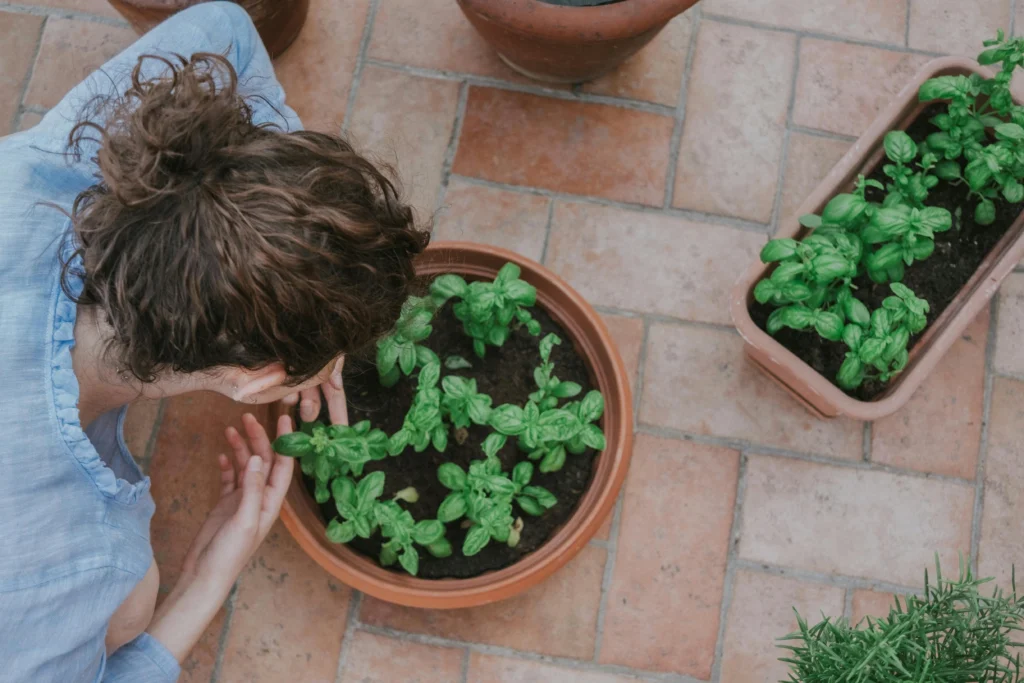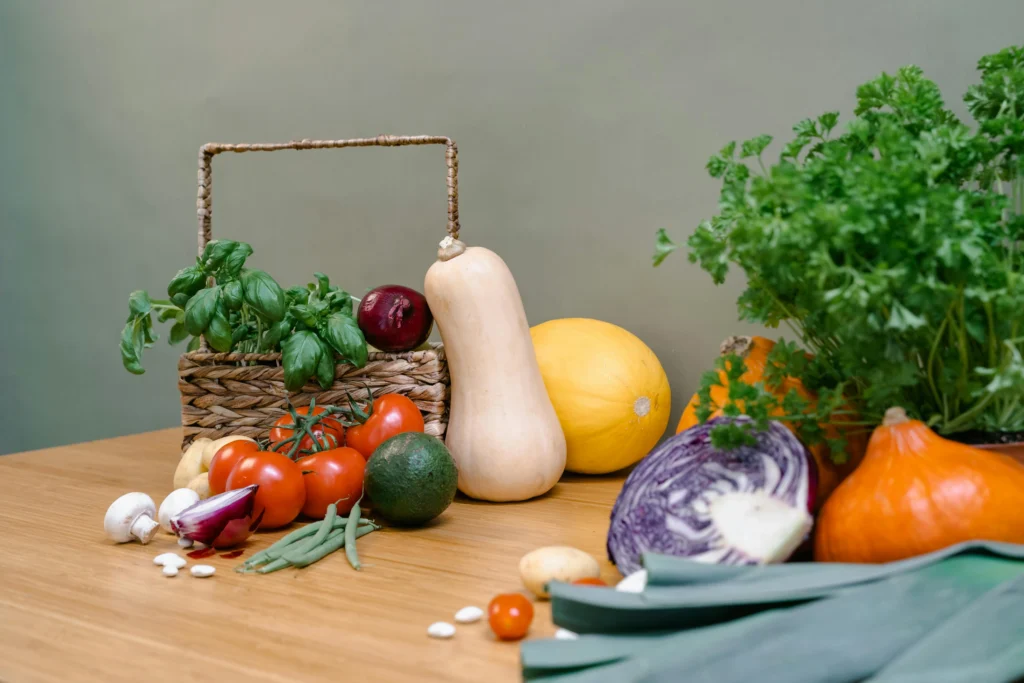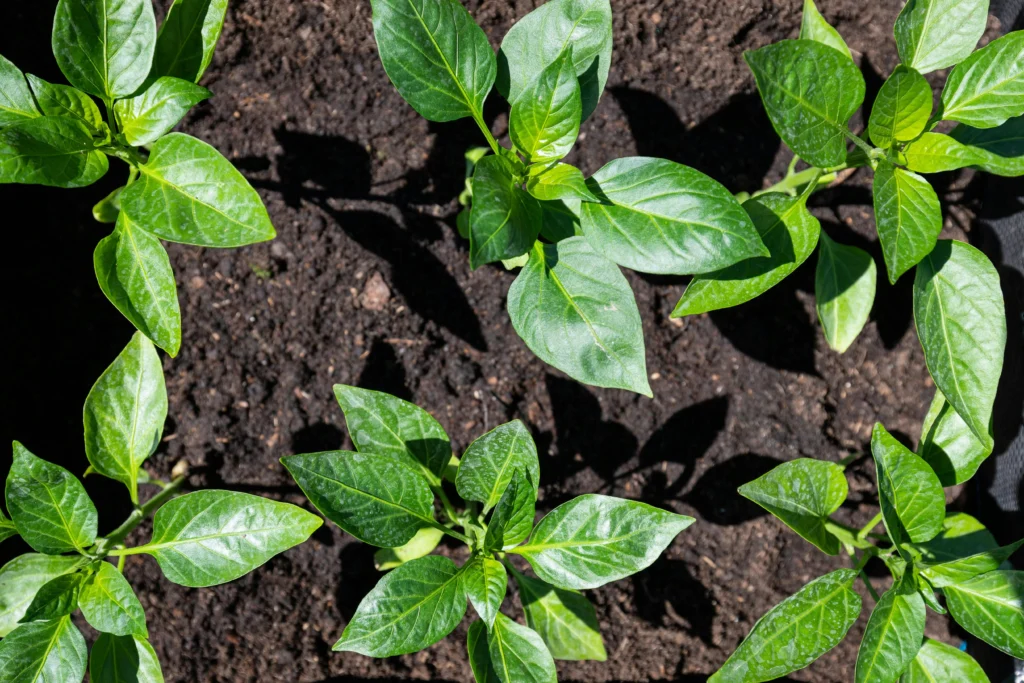Table of Contents
Introduction
Did you know that basil plant, that humble herb commonly added to pasta dishes and salads, has more to offer than just its delightful flavor? As it turns out, the basil plant is a powerhouse of health benefits, offering a range of positive effects on digestion, immunity, and overall wellness.
In this article, we will delve into the incredible health benefits of the basil plant. From its ability to boost your immune system to tips on growing basil indoors, you’ll discover why this versatile herb is a must-have in your garden or kitchen.
Key Takeaways:
- Adding basil to your diet can improve digestion and alleviate common digestive issues.
- Basil has immune-boosting properties that can help fight off illnesses and infections.
- There are various basil varieties, each with its own unique benefits and flavors.
- Growing basil indoors is a viable option for enjoying fresh basil year-round.
- The right soil composition and pH level are crucial for healthy basil plants.
Benefits of Basil for Digestive Health

Basil, a versatile herb, offers numerous benefits for digestive health. Incorporating basil into your diet can help ease indigestion, reduce bloating, and promote a healthy gut. Its natural healing properties and soothing effects make it a valuable addition to your digestive wellness routine.
One of the key benefits of basil is its ability to ease indigestion. The active compounds present in basil leaves help stimulate the production of digestive enzymes, aiding in the breakdown of food and reducing discomfort. Consuming basil after meals can provide relief from indigestion symptoms such as heartburn, stomach pain, and nausea.
In addition to easing indigestion, basil can help reduce bloating. Bloating is often caused by an accumulation of gas in the digestive system, leading to discomfort and a distended abdomen. The carminative properties of basil help relieve gas, preventing bloating and promoting a flat, comfortable stomach.
Key Benefits of Basil for Digestive Health:
- Eases indigestion: The active compounds in basil stimulate digestive enzymes, providing relief from symptoms such as heartburn, stomach pain, and nausea.
- Reduces bloating: Basil’s carminative properties help relieve gas, preventing bloating and promoting a flat, comfortable stomach.
- Promotes a healthy gut: Basil contains antimicrobial properties that can help fight harmful bacteria in the digestive tract, promoting a balanced gut microbiome and overall digestive health.
Incorporating basil into your daily routine is easy. You can add fresh basil leaves to salads, soups, or sauces for a burst of flavor and digestive benefits. Alternatively, you can brew basil tea by steeping fresh leaves in hot water for a soothing and aromatic beverage.
“Basil’s natural healing properties and soothing effects make it a valuable addition to your digestive wellness routine.”
By harnessing the digestive health benefits of basil, you can support your overall well-being and enjoy improved digestion. Whether in culinary creations or as a refreshing herbal tea, basil offers a natural and delicious way to nourish your digestive system.
Boosting Immunity with Basil Plant

Did you know that the basil plant possesses incredible immune-boosting properties? Incorporating this versatile herb into your daily routine can significantly support your immune system, helping you fight off common illnesses and infections. Discover the numerous benefits of basil for your immune health and learn how to make the most of this remarkable plant.
How Basil Supports Immunity
Basil is rich in essential nutrients and compounds that can help strengthen your immune system. It contains powerful antioxidants, such as eugenol, which have antimicrobial properties and help fight against harmful pathogens. Additionally, basil is packed with vitamins A, C, and E, as well as minerals like zinc and iron, all of which play a vital role in maintaining a robust immune response.
“The powerful antioxidants found in basil help fight against harmful pathogens, while essential vitamins and minerals support a robust immune system. It’s nature’s way of protecting our health.”
Tips for Incorporating Basil into Your Routine
Now that you understand the immune-boosting benefits of basil, here are some tips on how to include it in your daily life:
- Add fresh basil leaves to your salads, soups, or sandwiches for a burst of flavor and added nutritional benefits.
- Create a homemade basil-infused oil to use in cooking or as a dressing for salads.
- Brew a refreshing cup of basil tea by steeping fresh basil leaves in hot water. Add a squeeze of lemon and a drizzle of honey for added taste.
- Blend fresh basil leaves into your favorite smoothies to enjoy its immune-boosting goodness.
Basil Immunity-Boosting Recipes

Discover the delicious world of basil with these immune-boosting recipes:
| Recipe | Description |
|---|---|
| Basil Pesto Pasta | A classic Italian dish that combines the vibrant flavors of basil with garlic, pine nuts, parmesan cheese, and olive oil. Serve over pasta for a satisfying meal. |
| Basil Lime Smoothie | A refreshing smoothie made with fresh basil leaves, lime juice, Greek yogurt, honey, and ice. Blend until creamy and enjoy a burst of citrus and herbal flavors. |
| Basil Tomato Salad | A light and flavorful salad featuring ripe tomatoes, fresh basil leaves, mozzarella cheese, and a drizzle of balsamic glaze. Perfect for a quick and healthy lunch or side dish. |
Embrace the power of basil and boost your immunity naturally. By incorporating this aromatic herb into your daily routine and exploring its culinary possibilities, you can enhance your immune health and enjoy a vibrant, energized life.
Basil Varieties and Their Unique Benefits
When it comes to basil, there are numerous varieties to choose from, each with its own distinctive flavor profile and unique health benefits. Whether you’re looking to add a hint of sweetness to your dishes or a touch of exotic spice, exploring different basil varieties can elevate your culinary creations and boost your well-being.
Here are some popular basil varieties and their special qualities:
| Variety | Flavor Profile | Health Benefits |
|---|---|---|
| Sweet Basil | Fresh, slightly peppery | Rich in antioxidants and anti-inflammatory properties |
| Thai Basil | Spicy, anise-like | Contains essential oils that aid digestion and reduce stress |
| Genovese Basil | Intense, sweet, and slightly spicy | Packed with vitamins A, K, and C to support overall health |
| Lemon Basil | Citrusy, refreshing | Contains high levels of citral, known for its mood-boosting properties |
These are just a few examples of the basil varieties available, each offering its own culinary versatility and health benefits. Experimenting with different basil varieties can add depth and complexity to your meals while providing valuable nutrients for your body.
Next, we’ll delve into the tips and techniques for successfully growing basil indoors, ensuring a regular supply of fresh herbs for your culinary adventures.
Tips for Growing Basil Indoors

Do you love the fresh aroma and taste of basil? With these expert tips and tricks, you can successfully grow basil indoors and enjoy this flavorful herb year-round, even with limited space. Whether you’re a seasoned gardener or a beginner, follow these guidelines to ensure a thriving indoor basil plant.
1. Choose the Right Container
When growing basil indoors, selecting the appropriate container is crucial. Opt for a pot or planter that has drainage holes to prevent waterlogging. Additionally, make sure the container is large enough to accommodate the roots and provide adequate room for growth.
2. Provide Optimal Lighting
Basil requires a good amount of sunlight, preferably 6-8 hours daily. Place your indoor basil plant near a south-facing window or under grow lights to ensure it receives sufficient light. If natural light is limited, consider using artificial lighting sources specifically designed for plant growth.
3. Maintain Proper Watering
Overwatering can lead to root rot, while underwatering can cause wilting and stunted growth. Keep the soil consistently moist but not overly saturated. To determine when it’s time to water, check the top inch of soil. If it feels dry to the touch, it’s time to water your basil plant.
4. Ensure Adequate Air Circulation
Basil plants thrive in environments with good air circulation. Place a small fan near your indoor basil plant to provide gentle air movement, which helps prevent the development of fungal diseases and strengthens the plant’s overall health.
5. Maintain the Right Temperature
Indoor basil plants prefer temperatures between 65-80°F (18-27°C). Avoid exposing them to extreme cold or hot drafts, as this can stress the plant and hinder its growth. Keep the basil plant away from air conditioning vents or heaters.
6. Fertilize Regularly
To promote vigorous growth and ensure a bountiful harvest, regularly fertilize your indoor basil plant. Choose a balanced organic fertilizer and follow the manufacturer’s instructions for application. Avoid overfertilizing, as it can result in weak, leggy plants.
7. Prune for Bushier Growth
Pruning is essential for encouraging bushier growth and preventing your basil plant from becoming lanky. Pinch off the tips of the stems regularly and remove any yellowing or damaged leaves. This will promote more compact growth and a higher leaf yield.
“Growing basil indoors allows you to enjoy the fresh flavor of this versatile herb all year round. With the right care and attention, you can have a thriving indoor basil plant that enhances your culinary creations and adds a touch of greenery to your home.” – Expert Gardener
Follow these tips to successfully grow basil indoors and savor the delightful aroma and taste of this incredible herb whenever you desire.
Best Soil for Growing Basil
The right soil composition and pH level are essential for growing healthy and vibrant basil plants. By understanding the ideal soil conditions and implementing proper preparation and maintenance techniques, you can ensure the optimal growth and abundant harvest of your basil plants for both culinary and medicinal purposes.
Ideal Soil Composition
Basil plants thrive in well-draining soil with good moisture retention. The ideal soil composition for growing basil should consist of:
- Loamy soil: Loam soil provides a balanced mix of clay, silt, and sand particles, ensuring proper drainage without excessive water loss or compaction.
- Organic matter: Incorporating organic matter, such as compost or well-rotted manure, enriches the soil with essential nutrients, improves moisture retention, and promotes healthy root development.
- Adequate fertility: Basil plants require a fertile soil enriched with essential nutrients like nitrogen, phosphorus, and potassium. Before planting basil, consider adding a balanced organic fertilizer to ensure adequate nutrition.
Optimal pH Level
The pH level of the soil directly affects nutrient availability and plant growth. Basil plants prefer a slightly acidic to neutral pH range of 6.0 to 7.5. Testing your soil’s pH level before planting basil can help you make necessary adjustments to create the ideal environment for healthy growth.
Soil Preparation and Maintenance
Proper soil preparation and maintenance are crucial for ensuring the health and productivity of your basil plants. Here are some key steps to consider:
- Clear the planting area: Remove any weeds, rocks, or debris from the planting area to create a clean and unobstructed space for your basil plants.
- Amend the soil: Incorporate organic matter, such as compost or well-rotted manure, into the soil to improve its fertility, structure, and moisture retention capacity.
- Adjust pH, if necessary: If your soil’s pH is outside the optimal range, consider making adjustments by adding soil amendments, such as lime to increase pH or sulfur to decrease pH, as recommended by a soil test.
- Provide proper drainage: Ensure that your soil has good drainage to prevent waterlogged roots and potential disease issues. If your soil is heavy and retains excessive moisture, consider adding amendments like sand or perlite to improve drainage.
- Maintain moisture levels: Basil plants require consistent moisture, so water the plants regularly, keeping the soil evenly moist without overwatering. Avoid letting the soil overly dry out or become fully saturated.
By following these guidelines for soil composition, pH level, and preparation, you can create an optimal environment that supports the healthy growth and productivity of your basil plants. Remember to monitor your plants’ needs and make adjustments as necessary to ensure they thrive and provide you with a bountiful supply of fresh basil leaves.
| Soil Type | Drainage | Moisture Retention | Fertility | pH Range |
|---|---|---|---|---|
| Loamy Soil | Good | High | Medium to High | 6.0-7.5 |
| Sandy Soil | Fast | Low | Low to Medium | 6.0-7.5 |
| Clay Soil | Poor | High | High | 6.0-7.5 |
| Chalky Soil | Slow | Low | Low to Medium | 6.0-7.5 |
Harvesting and Preserving Basil
Harvesting basil at the right time is crucial to preserving its delightful flavor and maximizing its nutritional benefits. In this section, we will provide you with expert tips on when and how to harvest basil leaves, ensuring an explosion of taste and aroma in your culinary creations. We will also delve into various methods for preserving basil, including drying, freezing, and making aromatic basil-infused oils. Get ready to elevate your basil experience to new heights!
When it comes to harvesting basil, timing is everything. The best time to harvest basil leaves is in the morning, after the dew has dried and before the heat of the day sets in. This is when the basil plant’s oils are most concentrated, resulting in optimal flavor. Ensure that your basil plants have grown to a height of at least 6-8 inches before you start harvesting. This allows the plants to establish a good root system and ensures continuous growth throughout the season.
The Step-by-Step Guide to Harvesting Basil
- Inspect your basil plants and select stems with multiple leaves that are green and vibrant.
- Using a sharp pair of garden shears or scissors, cut the stem just above a pair of healthy leaves. Avoid cutting too close to the base of the plant as this may inhibit regrowth.
- Never remove more than one-third of the plant at once. This ensures that the basil plant remains healthy and continues to produce new leaves.
- Continue to harvest basil leaves regularly throughout the growing season to encourage new growth and prevent the plants from flowering.
Preserving the Freshness of Basil

While using freshly harvested basil is ideal, there are several preservation methods that can help you enjoy the flavor of basil all year round. Here are some popular techniques:
Drying: To dry basil, tie small bundles of stems together and hang them upside down in a well-ventilated area away from direct sunlight. Once completely dry, remove the leaves from the stems and store them in an airtight container.
Freezing: Freezing basil is a convenient way to preserve its vibrant flavor. Blanch the basil leaves in boiling water for a few seconds, then immediately plunge them into an ice bath to stop the cooking process. Pat them dry and place them in airtight containers or freezer bags.
Making basil-infused oils: Infusing oils with fresh basil leaves is a fantastic way to capture the essence of this aromatic herb. Combine fresh basil leaves and olive oil in a blender or food processor, then strain the mixture to remove any solids. Transfer the basil-infused oil into sterilized bottles or jars, and store in a cool, dark place.
By using these preservation methods, you can enjoy the delightful flavor of basil throughout the year, even when the growing season has come to an end. Experiment with different preservation techniques to find the one that best suits your culinary needs and preferences.
Common Diseases in Basil Plants and Prevention Tips
Just like any other plant, basil is susceptible to diseases that can hinder its growth and vitality. It’s important for basil growers to be aware of common diseases that can affect their plants and take proactive measures to prevent and treat them. By understanding these diseases and implementing preventative strategies, you can ensure that your basil plants stay healthy and vibrant.
Fungal Infections
Basil plants are prone to various fungal infections, including powdery mildew, downy mildew, and fusarium wilt. These infections can cause leaf discoloration, wilting, and stunted growth. To prevent fungal infections:
- Water your basil plant at the base, avoiding overhead watering.
- Space out your basil plants to allow for proper air circulation.
- Apply fungicides or natural remedies, such as neem oil or a baking soda spray, as preventative measures.
Pest Infestations
Basil plants can attract a variety of pests, including aphids, whiteflies, and spider mites. These pests can weaken the plants and transmit diseases. To prevent pest infestations:
- Inspect your basil plants regularly for signs of pests.
- Remove any infected or infested leaves promptly.
- Encourage beneficial insects, such as ladybugs, to control pest populations naturally.
- Use organic insecticides or homemade pest repellents, like garlic spray or insecticidal soap, if necessary.
Viral Infections
Basil plants can also be affected by viral infections, such as tomato mosaic virus (ToMV) or cucumber mosaic virus (CMV). These viruses typically spread through infected plant debris or insect vectors. While there are no specific treatments for viral infections in basil, prevention is key:
- Remove and destroy any infected plants or debris to prevent the spread of viruses.
- Practice good sanitation by washing hands and tools before working with your basil plants.
- Minimize the use of pesticides that can kill beneficial insects, as they play a role in controlling virus-carrying pests.
By being vigilant and implementing proper prevention techniques, you can protect your basil plants from diseases and ensure their long-term health. Regularly monitor your plants, provide optimal growing conditions, and address any issues promptly to keep your basil thriving.
Companion Plants to Grow with Basil
Basil is not only a valuable herb in its own right but also a fantastic companion plant for many other species. When strategically grown alongside compatible plants, basil can enhance their growth and deter pests, creating a harmonious garden ecosystem. Here are some of the best companion plants to consider growing alongside your basil:
Mint
Mint and basil are a perfect pairing. Mint’s strong aroma helps repel pests, while basil’s fragrance can enhance the flavor of nearby mint. Planting them together also maximizes the use of garden space.
Tomatoes
Tomatoes and basil are known for their culinary compatibility, but they also make excellent garden companions. The volatile compounds released by basil can help repel pests that commonly affect tomatoes, such as aphids and whiteflies.
Peppers
Basil and peppers thrive in similar growing conditions, making them ideal companions. Basil’s repellent properties can help deter pests like aphids and spider mites that may disrupt pepper plants.
Marigolds
Marigolds provide more than just vibrant color to your garden. They possess natural pest-repellent compounds that can protect basil from harmful insects like nematodes and aphids, improving overall plant health.
Lettuce
Pairing basil with lettuce not only adds visual appeal to your garden but also serves a practical purpose. Basil’s aromatic oils can help repel slugs, which are known to damage lettuce leaves.
Beans
Beans and basil make excellent bedfellows in the garden. Basil’s fragrance can attract beneficial insects that can pollinate bean plants, leading to better yields.
When choosing companion plants for basil, it’s essential to consider their compatibility in terms of growing conditions, pest resistance, and mutual benefits. By strategically interplanting basil with other compatible species, you can create a vibrant and thriving garden that benefits both your basil plants and their neighboring companions.
Conclusion
In conclusion, the basil plant is much more than just a flavorful herb. It is a powerhouse of health benefits that can significantly improve your well-being. By incorporating basil into your daily routine, you can take advantage of its natural healing properties and enjoy a vibrant and healthy lifestyle.
One of the key benefits of basil is its positive impact on digestive health. From easing indigestion to reducing bloating, basil can support a healthy gut and improve overall digestion. Additionally, the immune-boosting properties of basil can help strengthen your body’s defense against common illnesses and infections.
If you have limited outdoor space or live in a colder climate, don’t worry! You can still enjoy the benefits of basil by growing it indoors. With the right container and optimal growing conditions, you can have fresh basil year-round, ready to enhance your dishes and provide you with its medicinal value.
Lastly, it’s important to take care of your basil plants to ensure their health and longevity. By knowing the common diseases that affect basil and prevention tips, you can keep your plants thriving. Additionally, consider growing basil alongside companion plants that can enhance its growth and flavor.
FAQs
What are some health benefits of the basil plant?
The basil plant offers multiple health benefits, such as aiding digestion, boosting immunity, and providing natural healing properties. It is also known for its antioxidant and anti-inflammatory properties.
How do I grow basil indoors?
To grow basil indoors, choose a sunny location near a window, provide well-drained soil, water regularly but avoid overwatering, and ensure proper air circulation. It is also essential to maintain the right temperature and avoid drafts.
What are some popular basil plant varieties and their benefits?
Some popular basil plant varieties include sweet basil, Thai basil, and lemon basil. Sweet basil is commonly used in Italian cuisine, while Thai basil adds a unique flavor to Asian dishes. Lemon basil offers a refreshing citrus twist.
What is the best soil for growing basil?
Basil thrives in well-draining soil with a slightly acidic pH level. A mixture of compost, potting soil, and perlite or vermiculite can provide the ideal growing conditions for basil plants.
When and how should I harvest basil?
Basil can be harvested once the plant has developed enough leaves. Pinch off the young leaves just above a leaf node to encourage bushier growth. Harvest basil in the morning when the essential oils are at their peak.
What are some common diseases in basil plants and how do I prevent them?
Common diseases in basil plants include fungal infections (such as powdery mildew) and pest infestations (such as aphids and spider mites). To prevent diseases, ensure proper air circulation, avoid overwatering, and regularly inspect your plants for any signs of damage or infection.
Can basil be grown alongside other plants?
Yes, basil makes a great companion plant. It repels pests like mosquitoes and flies while attracting beneficial insects. It pairs well with tomatoes, peppers, and other herbs like parsley, oregano, and thyme.


No Responses